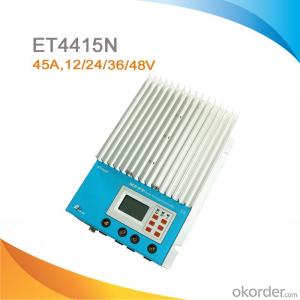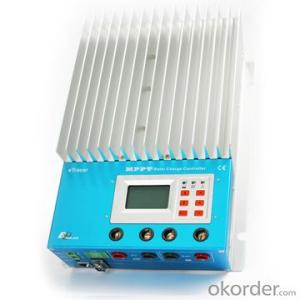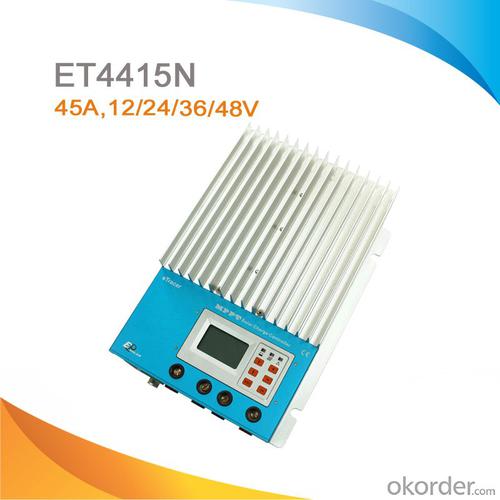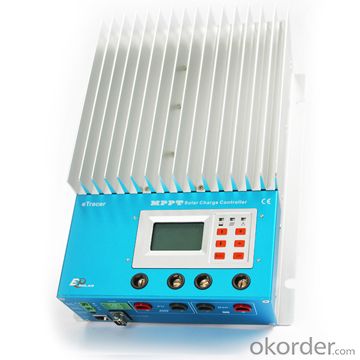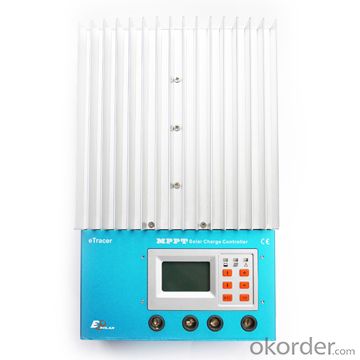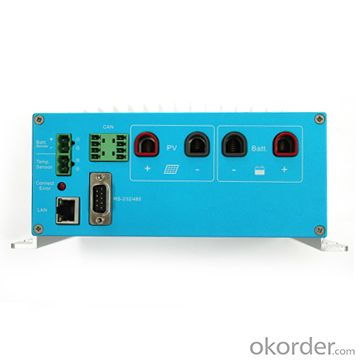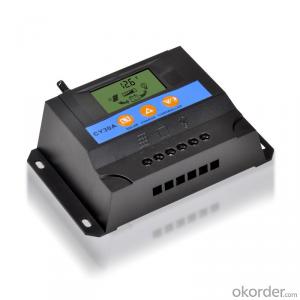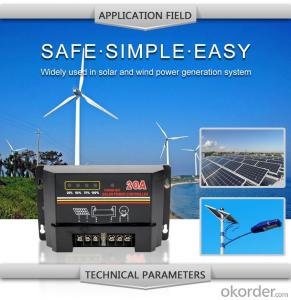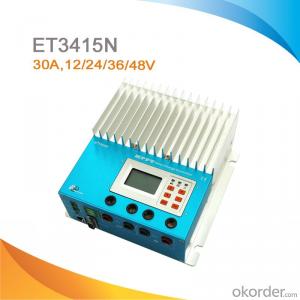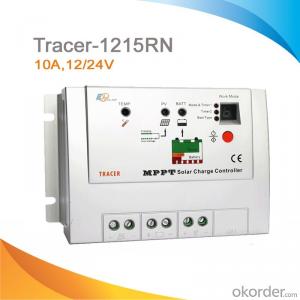Multiple Solar Controllers MPPT Solar Street Light Charge Controller 45A, 12/24/36/48V, ET4415N
- Loading Port:
- China main port
- Payment Terms:
- TT or LC
- Min Order Qty:
- -
- Supply Capability:
- -
OKorder Service Pledge
OKorder Financial Service
You Might Also Like
Specifications
MPPT charge controller
Maximum power point tracker
temperature compensation
LCD display
Communicate with PC
Features:
·12/24/36/48V auto work
·Advanced MPPT technology
·Several seconds tracking speed
·High Tracking efficiency of 99%
·Multiphase synchronous rectification technology
·Peak conversion efficiency of 98%
·DSP&ARM processors architecture ensures high speed and performance
·Gel, Sealed, Flooded battery option
·Max. 450 days data logging by connection to PC
·Multifunction LCD displays system data and status
·Three kinds of communication ports :RS232, CAN BUS and Ethernet
·Three stages charging optimizes battery performance
·Software update by users
Specification:
Model | ET3415N | ET4415N | ET6415N |
Rated system voltage | 12V/24V /36V/48V auto work | ||
Rated battery current | 30A | 45A | 60A |
Max. PV open circuit voltage | 150V | ||
Voltage range | 8~72V | ||
Max.PV input power | 400W (12V) | 600W (12V) | 800W (12V) |
800W (24V) | 1200W (24V) | 1600W (24V) | |
1200W (36V) | 1800W (36V) | 2400W (36V) | |
1600W (48V) | 2400W (48V) | 3200W (48V) | |
Self-consumption | 1.4~2.2W | ||
Grounding | Negative | ||
Dimension | 231x203x105mm | 285x203x105mm | 285x203x121mm |
Terminal | 35mm2 | 35mm2 | 35mm2 |
Net Weight | 4.1kg | 4.4kg | 5.0kg |
Working temperature | -25℃~+55℃ | ||
Storage temperature range | -30℃~+85℃ | ||
Humidity | 10%-90% NC | ||
Enclosure | IP20 | ||
Altitude | ≤3000m | ||
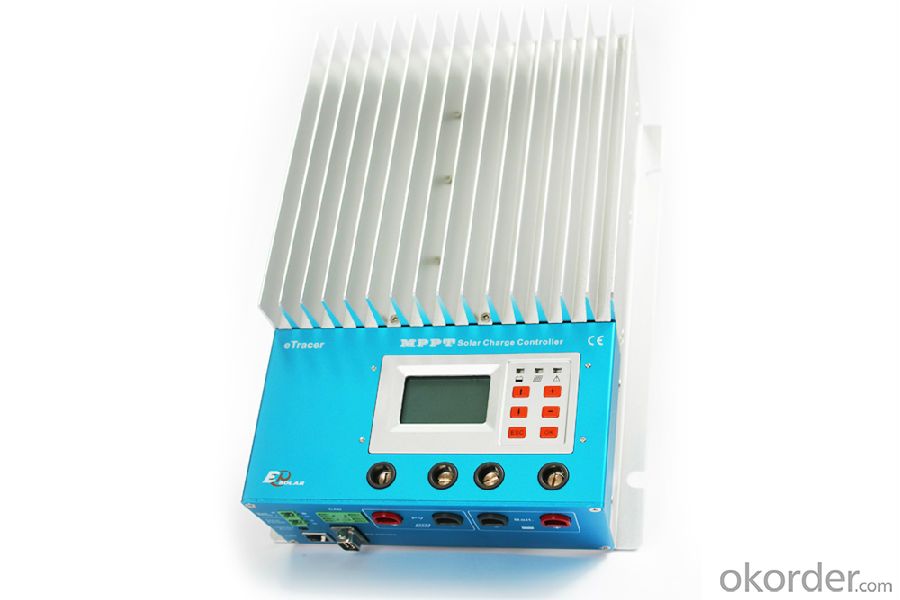

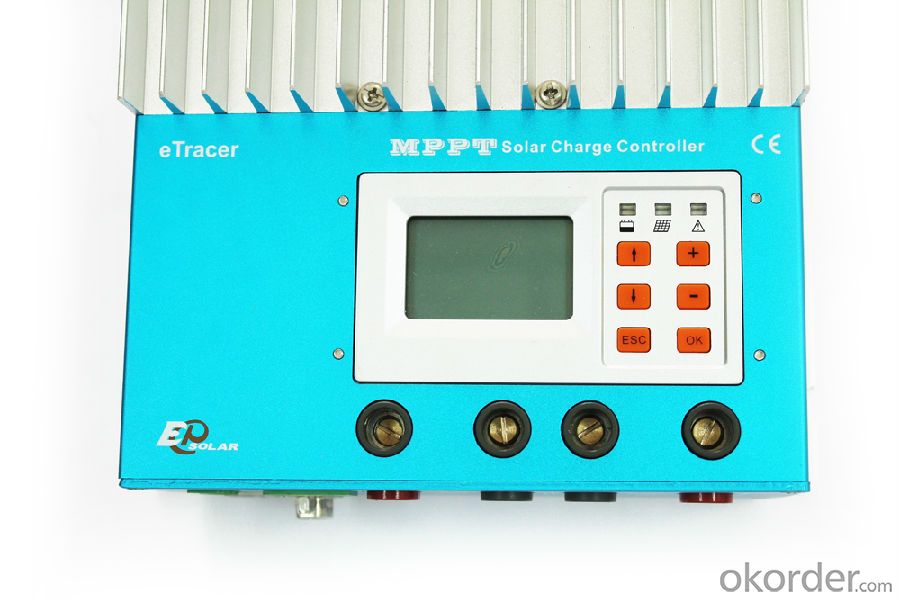
FAQ:
Q1. What is the voltage?
A1. Our 45/60A solar charge controller is 12/24/36/48V auto work.
Q2. What is the difference between MPPT&PWM?
A2. MPPT has higher efficiency, it can track the max power point and won't waste energy.
Q3. What is the efficiency of the MPPT controller?
A3. MPPT>99%, peak conversion efficiency>98%.
Q4. What is the waranty of product?
A4. 12 months.
Q5. What protection does your MPPT controller have?
A5. PV array short circuit, PV reverse polarity, Battery reverse polarity, Over charging, Output short circuit.
- Q: How does a solar controller handle battery capacity testing?
- A solar controller handles battery capacity testing by monitoring the voltage and current of the battery during the charging and discharging process. It uses this data to calculate the state of charge (SOC) of the battery, which indicates the remaining capacity. The solar controller may also use algorithms to estimate the battery capacity based on its performance over time.
- Q: How does a solar controller protect batteries from deep discharge?
- A solar controller protects batteries from deep discharge by monitoring the battery voltage and disconnecting the load when the voltage drops below a certain threshold. This prevents the batteries from being drained to a dangerously low level, which can lead to permanent damage or reduced lifespan.
- Q: What are the temperature compensation features in a solar controller?
- Temperature compensation features in a solar controller refer to the functionality that allows the controller to adjust and optimize its charging parameters based on the temperature of the solar panels. This compensation is necessary because the efficiency of solar panels can vary with temperature, affecting the charging process. By compensating for temperature changes, solar controllers can ensure that the charging voltage and current are adjusted accordingly to maximize the performance and lifespan of the solar system.
- Q: Can a solar controller be used with a solar-powered backup generator?
- Yes, a solar controller can be used with a solar-powered backup generator. The solar controller helps regulate and control the flow of electricity from the solar panels to the generator's batteries, ensuring optimal charging and preventing overcharging.
- Q: How do MPPT solar controllers work?
- MPPT solar controllers work by continuously tracking and adjusting the electrical impedance of the solar panel to maximize the power output. They achieve this by measuring the voltage and current of the panel, and then calculating the optimal operating point where the output power is highest. This information is used to dynamically adjust the load impedance, allowing the solar panel to operate at its peak efficiency and extract maximum energy from the sunlight.
- Q: Can a solar controller be used in a solar-powered electric train system?
- Yes, a solar controller can be used in a solar-powered electric train system. A solar controller is responsible for regulating the voltage and current flow from the solar panels to the battery or power storage system. In a solar-powered electric train system, solar panels would generate electricity to power the train, and the solar controller would ensure proper charging and management of the system's battery or power storage.
- Q: What is the maximum charging voltage a solar controller can provide?
- The maximum charging voltage a solar controller can provide typically depends on the specific model and its design. However, the range is commonly between 13.8 to 14.8 volts for a 12-volt system and 27.6 to 29.6 volts for a 24-volt system.
- Q: Can a solar controller be used with solar panel ground screws?
- Yes, a solar controller can be used with solar panel ground screws. The solar controller is responsible for regulating the charging and discharging of the battery connected to the solar panel system. The ground screws, on the other hand, provide stability and support to the solar panels by firmly anchoring them to the ground. These two components serve different functions and can be used together to ensure the efficient operation of the solar panel system.
- Q: Does a solar controller have surge protection?
- Yes, a solar controller typically includes surge protection. Surge protection is a crucial feature in solar controllers as it safeguards the solar panels and other components of the solar system from voltage spikes and power surges. These spikes can occur due to lightning strikes, grid fluctuations, or other electrical disturbances, and can potentially damage or destroy the solar controller and other connected devices. Surge protection in a solar controller helps to absorb and redirect these voltage spikes, ensuring the smooth and safe operation of the solar system.
- Q: What are the indicators and displays on a solar controller for?
- The inclusion of indicators and displays in a solar controller is crucial for the monitoring and management of a solar power system. These features offer valuable insights into the functioning and status of both the solar controller and the overall solar energy system. The main objective of these indicators and displays is to provide real-time information regarding the charging and discharging of the batteries that are connected to the solar system. This information encompasses battery voltage, current, state of charge (SOC), and battery temperature. By keeping an eye on these indicators, users can evaluate the condition and performance of their batteries and take appropriate action if any issues arise. Moreover, these indicators and displays often present data on the output of the solar panels, including the current generated, the voltage produced, and the overall power generation. This allows users to monitor the efficiency and effectiveness of their solar panels and make adjustments as necessary. Furthermore, certain solar controllers come equipped with built-in data logging capabilities, enabling users to track historical data on energy production, battery performance, and other pertinent metrics. This data can be utilized for analysis, troubleshooting, and optimizing the performance of the solar power system. In addition, indicators and displays on a solar controller can issue alerts and notifications for various conditions, such as low battery voltage, overcharging, or overheating. These warnings help users identify potential problems and take prompt action to prevent any damage to the system or ensure its optimal performance. All in all, the indicators and displays on a solar controller function as a comprehensive monitoring and control system for solar power systems, providing crucial information on battery status, solar panel performance, and system health. Armed with this information, users can make well-informed decisions, maximize energy efficiency, and ensure the longevity of their solar power system.
Send your message to us
Multiple Solar Controllers MPPT Solar Street Light Charge Controller 45A, 12/24/36/48V, ET4415N
- Loading Port:
- China main port
- Payment Terms:
- TT or LC
- Min Order Qty:
- -
- Supply Capability:
- -
OKorder Service Pledge
OKorder Financial Service
Similar products
Hot products
Hot Searches
Related keywords
